Last updated: January 2nd, 2023
Depending on whom you ask, bike geometry either lets you predict fit and ride quality with scientific precision…or it’s some sort of voodoo.
Some folks will get hot and bothered on forum threads about the impact of a half-degree change in head tube angle. And don’t even get them started on high versus low trail…
Others haven’t the slightest idea what these terms mean and are no less happy for it.
The fact is that you interact with a bike’s geometry whether or not you consciously think about it.
It’s not essential to understand, but knowing some basic concepts will help you make sense of what you’re experiencing on the bike, and perhaps evaluate new bikes a little more easily.
This article might contain affiliate links. As a member of programs including Amazon Associates, I earn from qualifying purchases.
How important is bike geometry?
Bike geometry can help predict or explain how a bike feels to ride. It can also be misleading, since differences on charts don’t always matter in the real world. Remember that bike geometry doesn’t exist in a vacuum. Components like tires, handlebars, and saddles matter at least as much.
What difference does bike geometry make? All else being equal, geometry affects how you sit on the bike and how it responds to handling, obstacles, and cargo. For that reason, not only do bikes for different purposes use different components, but they have significantly different geometry, too.
Bike geometry that’s actually worth understanding
You could write an encyclopedia on bike geometry—and I’m willing to bet someone already did—so we’re going to take a more pragmatic approach.
Amid all the calculations and charts, there are a few that most significantly and reliably affect you as a commuter, leisure rider, or otherwise non-hardcore cyclist.
Below are the ones I consider the most important or useful. I’ll give a quick definition and diagram for each, an explanation of why it matters, and finally a very approximate range.
(You’ll find many exceptions to those ranges, especially with very small or very large sizes.)
Anyhow, in no particular order…
Standover height
What is bicycle standover height? The distance from the ground to the center of the top tube.
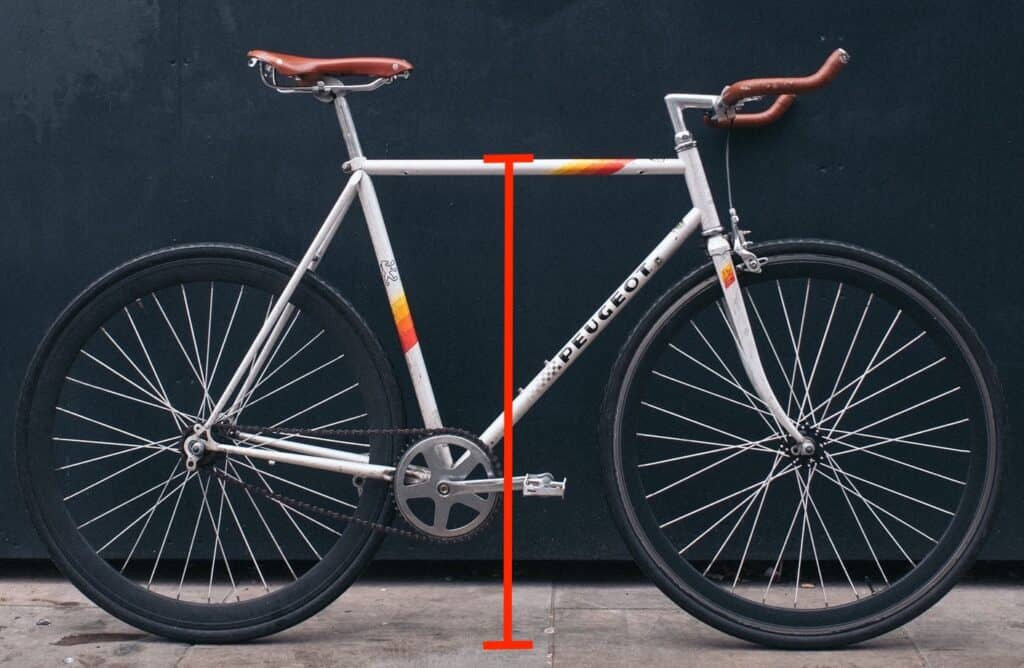
Why does standover height matter? It tells you whether you can comfortably stand over the bike when you’re stopped or getting on/off. That’s obviously important to avoid injury, especially during unplanned or emergency stops.
Mountain bikes and many modern (“compact”) road bikes have a downward curve or angle to the top tube, which reduces standover height without significantly changing the strength of the frame.
By definition, mixte and step-through frames have extremely low standover height, so it’s not a sizing factor. Both are often (and inaccurately) marketed as “women’s” frames, although they’re very useful to anyone with rear cargo (or a child) that they’d rather not swing a leg over.
Riders with shorter legs and longer torsos also benefit from a step-through or mixte design.
They’re not quite as stiff as regular diamond frames, since the top tube joins to the seat tube at a lower point. It forms a smaller and therefore weaker triangle. But unless you’re riding hard or carrying enormous cargo, that’s seldom a problem.
What are typical standover height numbers? Traditional road bikes have standover height from under 700 mm to over 850 mm depending on frame size. Modern mountain bikes and compact road bikes are lower, typically 650-800 mm.
Mixte and step-through standover heights are very low regardless of size—often well under 500 mm.
Seat tube length
What is seat tube length? The distance from the bottom bracket to either the joint with the top tube or the very end of the seat tube.
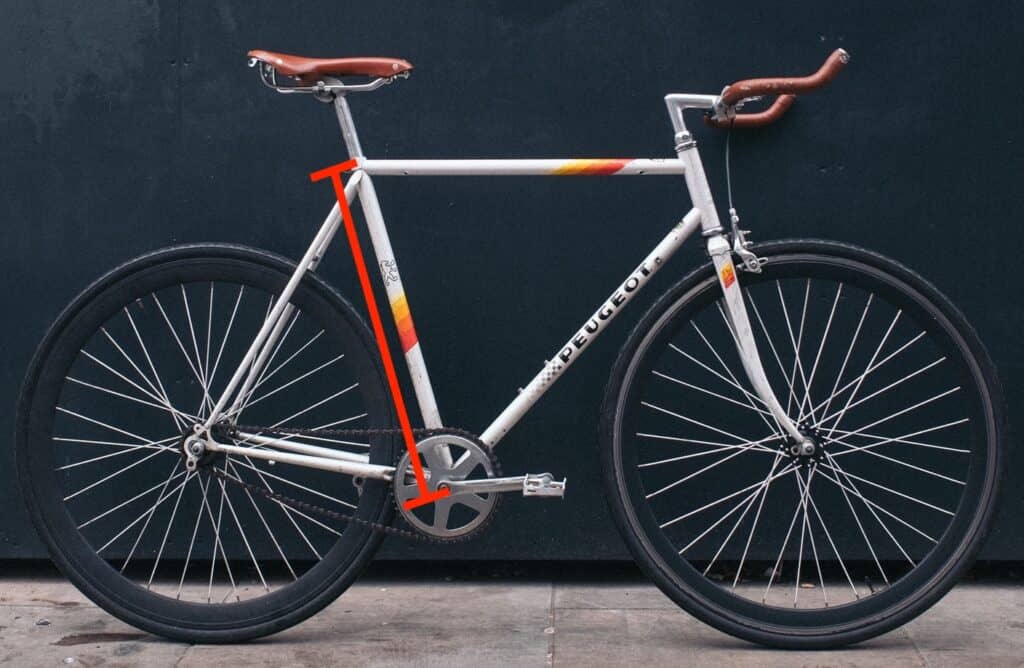
When measured from bottom bracket to top tube, it’s called “center to center” or “c-c.” When measured from bottom bracket to the actual end of the seat tube, it’s called “center to top” or “c-t.”
That distinction sounds pedantic, but it changes the measurement by an inch or two. If you’re comparing between manufacturers, it’s important to use either c-c or c-t for both. The manufacturer usually makes this clear in their geometry chart or diagram, and may even provide both numbers.
Note that many mountain bikes have curved or interrupted seat tubes, in which case the number is just an imaginary line between those two points. It may be referred to as the “effective seat tube.”
Why does seat tube length matter? It’s an indication of size and fit, since longer seat tubes accommodate taller riders. You can always buy a longer seatpost if needed, but suggests a proper fit if you have the right saddle height with only a few inches of seatpost extension.
Not only does an extremely short seat tube + long seatpost flex more and look slightly odd, but it probably means the bike is the wrong size in general.
However, seat tube length is more loosely related to sizing now that compact geometry is so common. (See the FAQ at the bottom for more detail.)
What are typical seat tube lengths? Around 480 mm to upwards of 650 mm is common on diamond-frame road bikes, but other styles may be under 400m.
Road and hybrid bikes sizes are often given as the seat tube length in centimeters, so a size “56” indicates a 56 cm/560 mm seat tube.
Top tube length
What is top tube length on a bicycle? The distance from the center of the head tube to the center of the seat tube.
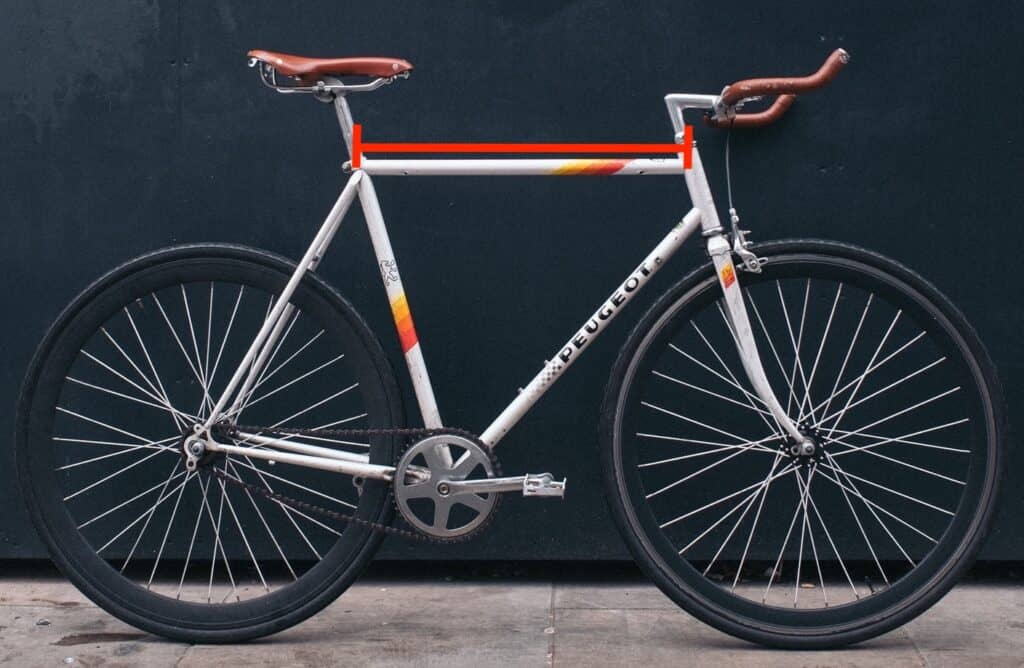
If measured point to point, it’s called the “actual top tube.” This is a useful measurement for traditional diamond frames with a perfectly flat top tube.
However, that’s less meaningful with the sloping or curved top tubes that are so common nowadays.
Instead, most manufacturers now give the “virtual,” “effective,” or “horizontal” top tube length instead. This is in imaginary horizontal line that extends from the center of the head tube to where the seat tube would intersect it.
Why does top tube length matter? It determines how long the bicycle will feel. Riders with longer torsos and arms need a longer top tube, but handlebar style is a huge factor.
Picture two bikes with identical frames but different handlebars. One has drop bars which put your hands a few inches in front of the head tube. The other has swept-back handlebars which put your hand a few inches behind the head tube.
Those handlebars change the cockpit length enormously. Frames designed for the same rider height will use a shorter top tube for drop bars versus longer top tube for flat/swept-back bars.
What’s more, a longer top tube stretches you out and makes the front end feel lower. It’s important to think about length relative to stack, which we’ll cover in a moment.
(There’s a related measurement called reach, which is the horizontal distance from the bottom bracket to the top of the head tube. It’s just the front portion of the effective top tube length. That isn’t too meaningful on its own, but it can help you tell whether two similar frames get more of their top tube length from the front versus rear portion.)
What are typical top tube lengths? Effective top tubes are usually around 530-610 mm for drop bars. Around 580-650 mm is more common with other handlebar styles.
Traditionally, a road bike has matching seat tube and top tube length for all but the smallest and largest sizes. For instance, both would be 560 mm on a size 56 frame. That’s increasingly rare on road bikes (and obsolete on other styles) now that most manufacturers use some degree of top tube slope.
Stack
What is stack on a bicycle? The vertical distance from the bottom bracket to the top of the head tube. All else being equal, it tells you how high the front end of the bike feels.
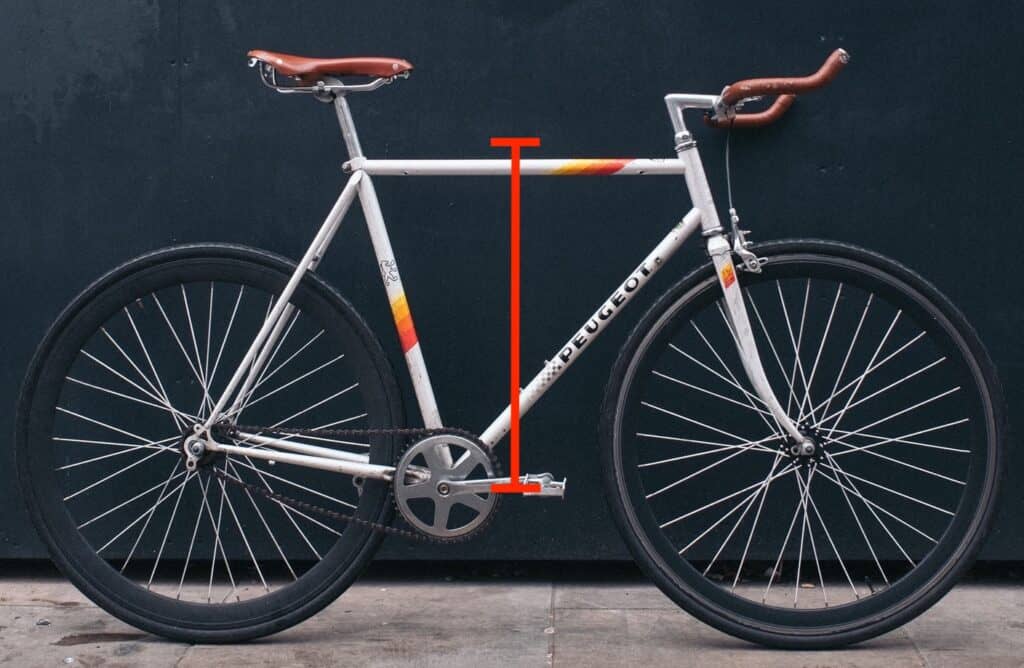
Why does stack matter? A taller rider needs more stack height to get the same posture as a shorter rider. Likewise, you’ll sit more upright on a bike with taller stack, assuming nothing else changes. Stack is like a baseline height that handlebar and stem changes can fine-tune.
As mentioned above, a long effective top tube forces you to stretch out more to reach the handlebars. Higher stack counteracts that, so stack increases on bigger bikes. For that matter, when you’re comparing two bikes with similar top tubes, it’s important to consider stack at the same time. (Not to mention stem length and handlebar reach, but those are easily changed if you like.)
What are typical stack numbers? You’ll often see about 500-600mm for road bikes, 530-630mm for hybrid and some mountain bikes, and 580-660mm for most mountain and city bikes.
Head tube angle
What is head tube angle? The angle between the head tube (where the fork inserts) and the ground under the bike.
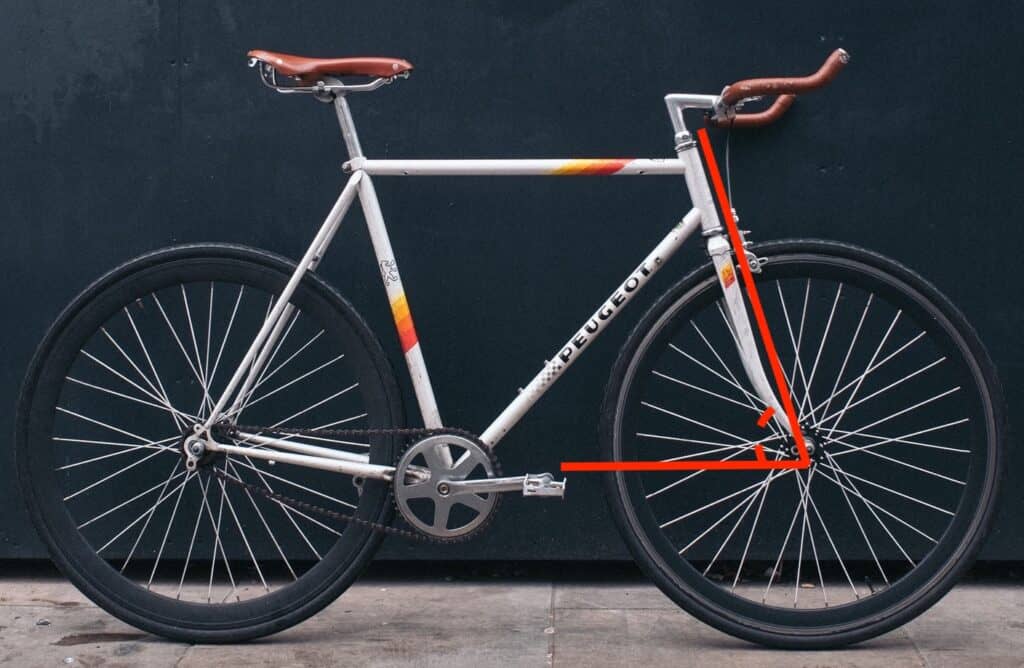
Why does head tube angle matter? A steeper angle will turn more quickly, which increases agility especially at low speeds. A relaxed (“slack”) head tube angle feels steadier and a bit slower to respond.
Road bikes tend to have the steepest head tube angles, partly because the rider’s forward posture and weight would otherwise deaden the handling. They’re slightly more relaxed on hybrids, but still in this vicinity.
On the other end of the spectrum, mountain bikes have far slacker head tube angles. That’s a notable difference between MTBs and hybrids that has widened over time. That helps them cruise over very rough terrain without getting knocked off course too easily.
Traditional Dutch bikes, cargo bikes, and cruisers also use very slack head tube angles. The goal is to easily keep a straight line with heavy loads or on rough streets.
What are typical head tube angles? Around 73-74° is typical for road bikes, roughly 70-72° for hybrids and older mountain bikes, roughly 68-71° for city bikes, and as slack as 63° on some modern mountain bikes.
It’s typically the same across sizes, but sometimes varies by about a degree to increase wheel-toe clearance on very small sizes.
Seat tube angle
What is seat tube angle? The angle between the seat tube and the ground behind the bike.
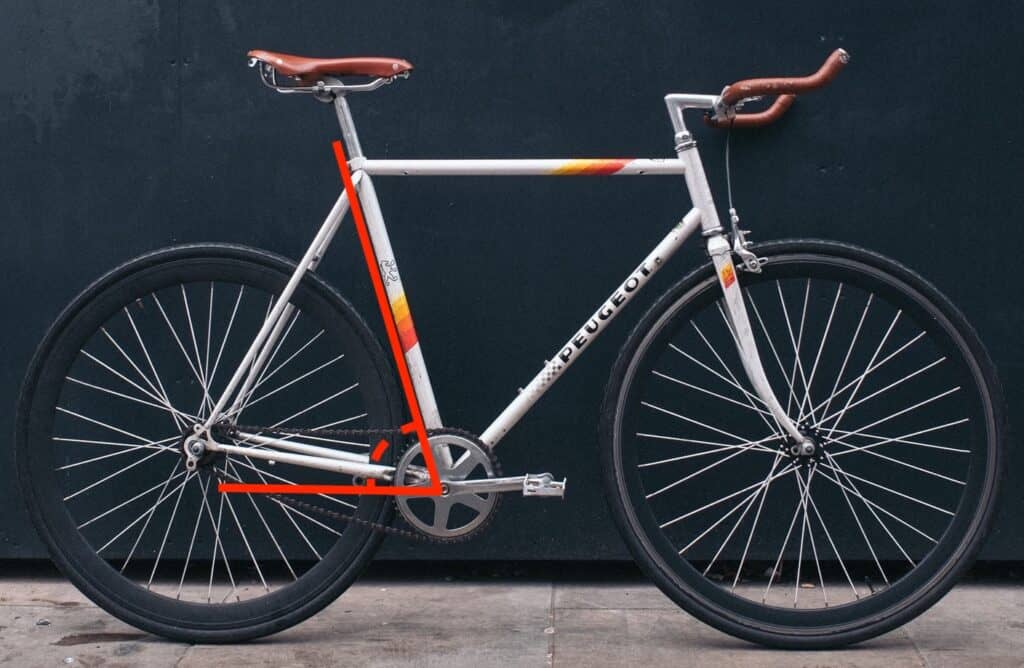
If the seat tube joins directly to the bottom bracket shell, then it’s measured against the actual seat tube. If the seat tube is offset from the bottom bracket, then it’s measured against an imaginary line from the bottom bracket to the end of the seat tube.
Why does seat tube angle matter? It affects how changing saddle height affects the fit of the bike. A steep seat tube angle (closer to vertical) means saddle-to-bars distance barely changes. A slack seat tube angle (tilted back) means that distance increases as saddle height increases.
Normally, it’s not very important, but slack angles are helpful if you need one bike to fit riders of different heights.
What are typical seat tube angles? It’s around 71° to 75° for most bicycles. However, city and Dutch bikes have seat tube as slack as 65-68°. Such slack angles make the bike feel longer as saddle height increases, so more people can share a single bike.
Chainstay length
What is chainstay length? The distance from the bottom bracket to the rear axle. It’s sometimes referred to as the “rear center” distance.

Why does chainstay length matter? Longer chainstays feel more stable at high speeds, especially when loaded up with cargo. They also keep your center of gravity in the right place when riding with upright posture.
Those are the main reasons that city and touring bikes have longer chainstays than most others.
Longer ones also increase heel clearance if you’re riding with a pannier. Most pannier can also be moved forward or backward as needed, but longer chainstays give a little more flexibility (especially with larger feet).
Finally, long chainstays arguably create a smoother ride. The rear axle is farther from the rider, so impacts to the rear wheel (i.e., bumps) are theoretically a bit milder. That’s questionable, and almost impossible to measure, so any perceived smoothness is probably just because of increased stability.
For a more detailed discussion, here’s a guide to why I love long chainstays and recommend them for the vast majority of us.
Conversely, shorter chainstays feel easier to manage in tight corners. That’s why modern mountain bikes use the shortest chainstays that still leave room for fat tires.
What’s more, short chainstays put the rear axle closer to your center of mass, so it’s easier to raise the front end for wheelies/manuals or to get over obstacles. But by the same token, short chainstays make it harder to keep the front end on the ground during extremely steep off-road climbs.
Road racing bikes also use short chainstays for a snappier feeling under acceleration. And while they do indeed feel quicker, I’ve yet to find any evidence that they are quicker.
Likewise, they’re only suitable for forward-leaning posture, so they’re uncommon on city and hybrid bikes. Otherwise, an upright rider’s center of gravity would be too close to the rear axle. (Incidentally, that’s a big reason that converting drop-bar road bikes to upright bars may result in funny handling.)
What are typical chainstay lengths? They’re typically 400-430 mm for mountain bikes and racing-oriented road bikes. Some road and track bikes may have chainstays as short as 390 mm or less, but that has largely fallen out of favor.
Touring and city bikes often range from 430-470 mm or even longer to maximize a) stability with cargo and b) handling with upright posture.
A few brands—most notably Rivendell—have chainstays up to 560 mm on their largest sizes!
On some models, chainstay length increases by a few millimeters along with with frame size. This helps keep rear-end length proportionate to front-end length. That’s not universal, but it’s increasingly common.
Bottom bracket height
What is bottom bracket height? It’s the vertical distance from the ground to the bottom bracket shell.
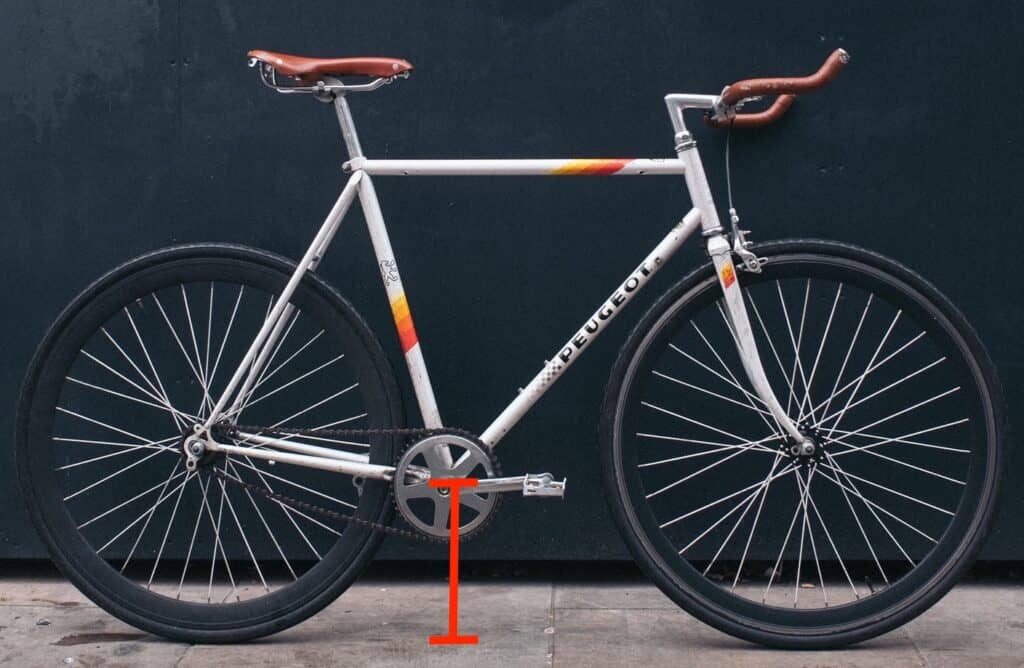
Why does bottom bracket height matter? Higher bottom brackets have better ground clearance, but feel less stable (due to a higher center of gravity), and make it harder to put your feet down at a stop. A lower bottom bracket makes the bike feel more stable, especially in corners, but also make it likelier to hit a pedal or chainring on obstacles.
City and touring bikes tend to have the lowest bottom brackets. They benefit from the extra stability, especially when carrying a load. And since they’re used mostly on pavement, obstacle clearance isn’t much of a concern.
Road and track racing bikes have slightly higher bottom brackets so riders can pedal continuously through corners. Even if they’d probably handle better with lower ones, it would be too easy to strike the ground while leaning into a high-speed turn.
Mountain and cyclocross bikes have typically had the highest bottom brackets due to the need to pedal over rocks, roots, etc. Full-suspension bikes in particular need that extra height to allow for suspension travel. But in recent years, they’ve generally gotten lower to improve high-speed stability and cornering.
All these comparisons assume tire sizing isn’t changing. Replacing tires with much smaller or larger ones will noticeably change the bottom bracket height and therefore the handling and ground clearance.
What are typical bottom bracket heights? For road and city bikes, 250-280 mm is common. Around 300-330 mm is more typical of hardtail mountain bikes, and full-suspension mountain bikes may use 330-360 mm or more.
Trail (offset)
What is trail on a bicycle? Trail, also known as offset, is the distance between where a vertical line through the front axle meets the ground and where an imaginary line through the steering axis meets the ground.
It’s a little complicated, so the diagram is especially important here. (We’re talking about that short, solid, horizontal line at the bottom of the front wheel, parallel to the ground.)
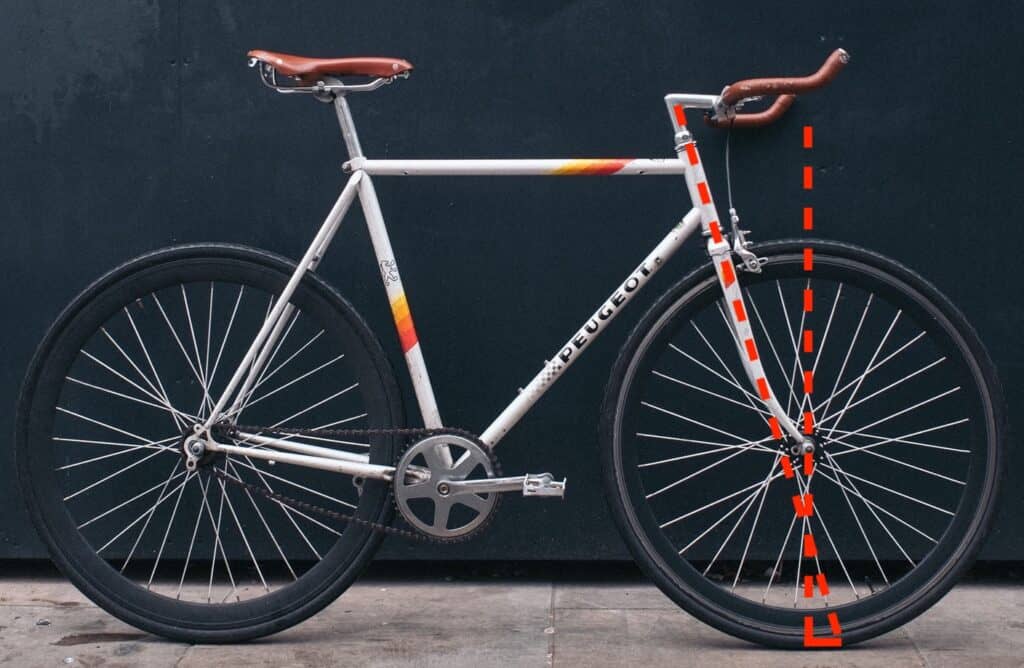
Why does trail matter? Low fork trail/offset makes steering feel more responsive whereas high trail feels more stable.
Low trail may also increase tire-toe clearance since it places the front axle farther from the riders.
Handling on low-trail bikes without a front load can feel twitchy and nervous. Handling on mid- to high-trail bikes with a front load may feel heavy and floppy—like it resists turning or straightening, then finally falls into or out of the turn.
Certain road and touring cyclists prefer to carry front loads, so low-trail designs are a hot topic among them, but not often discussed elsewhere.
What are typical trail numbers? For road and city bikes, roughly 30 mm of trail is considered low, and around 80 mm is quite high for pavement-oriented bikes. Most fall in the 50-70 mm range.
However, many mountain bikes have well over 100 mm of trail. The added stability is nice for rough terrain, plus their wide handlebars give plenty of leverage to offset slower handling.
A brief geometry FAQ
What’s the most important bicycle geometry number?
No single number is the most important, since they interact with each other. It’s better to think of geometry as a system.
For example, stack affects how a certain reach feels, bottom bracket height affects how a certain head tube angle feels, and so forth.
It’s just not useful to focus on any of these numbers in a vacuum, unless you’re trying to compare models that are nearly identical otherwise.
What is compact vs. traditional geometry on a road bike?
On road bikes with traditional geometry, the top tube is flat (horizontal). With compact geometry, the top tube slopes down to meet a shorter seat tube. The result is more standover clearance and more saddle height adjustment on an otherwise identical frame.
Manufacturers can make fewer sizes, and cyclists with shorter legs (low standover clearance) can easily get a good fit.
It uses slightly less material, which theoretically reduces weight and manufacturing costs. However, it’s debatable whether weight savings exist—especially considering that a short seat tube requires a longer seatpost.
It’s not always obviously at a glance, but gets clearer when you see traditional (black bike) and compact (white bike) geometry side-by-side.
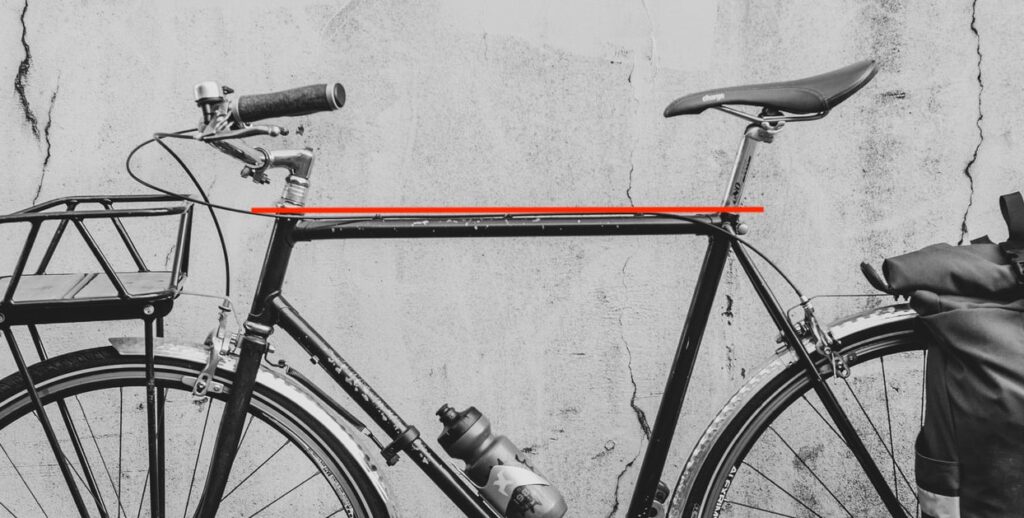
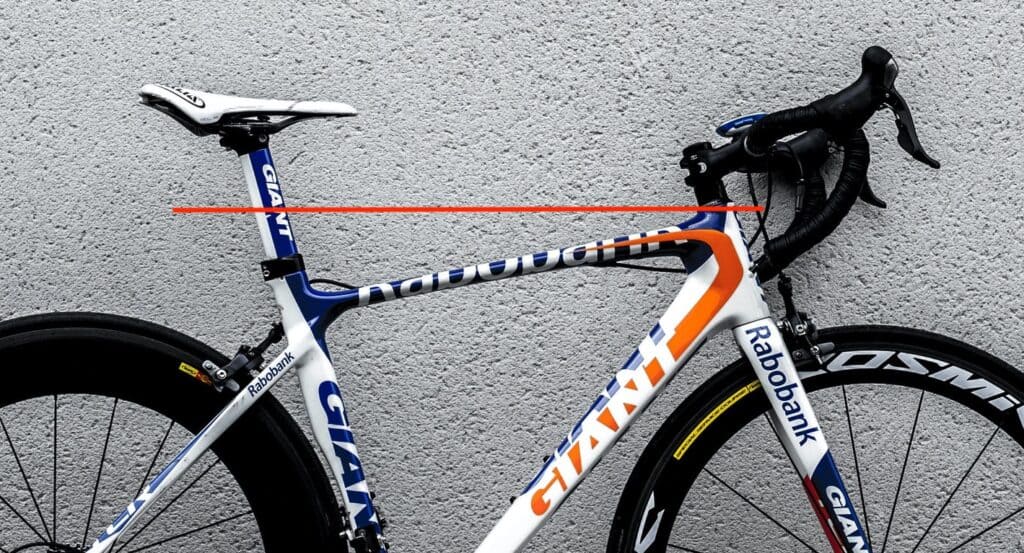
Should I choose a road bike with compact geometry? It does not matter unless you have an aesthetic preference, or you have shorter legs and require the extra standover clearance.
Many cyclists—myself include—like the traditional look of a traditional, flat top tube. There’s something appealingly classic about it, especially with a steel frame and more old-school parts.
Other cyclists—also including me—have shorter legs relative to their torsos, so getting adequate reach on a traditional frame would require a size that’s hard to stand over. In that case, compact geometry may be necessary.
What is aggressive geometry on a bicycle?
Aggressive geometry usually means low handlebars relative to the seat height, and generally steep head tube and seat tube angles. That usually implies short chainstays, too.
The quintessential example of aggressive geometry is a road, track, or time-trial racing bike. You’ll also see it with some XC racing mountain bikes, although it’s not used as often for MTBs in general.
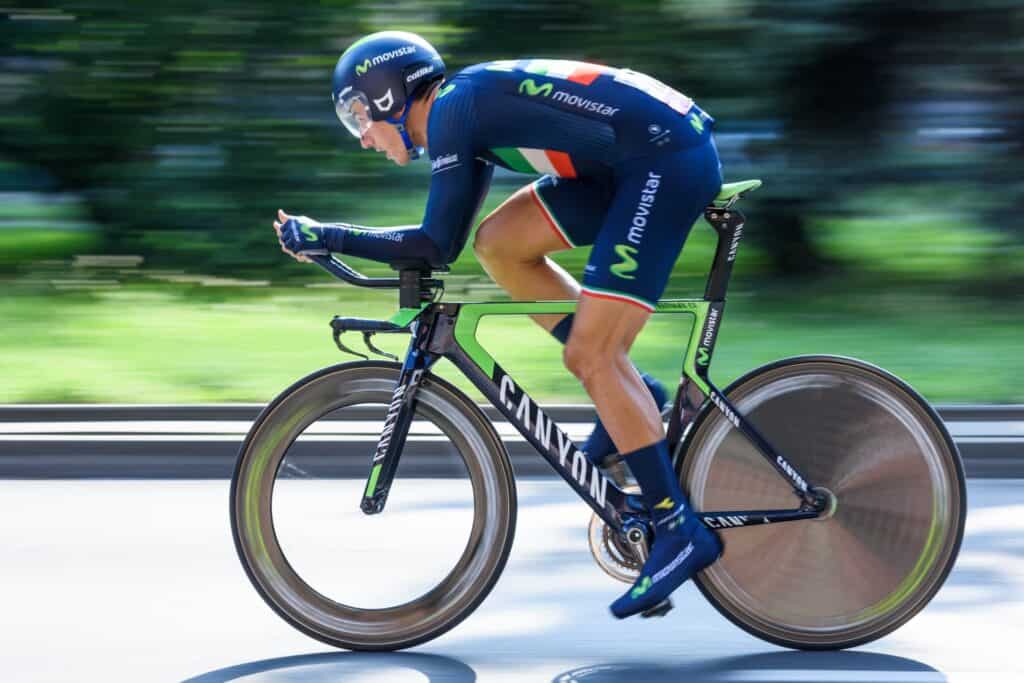
The opposite is usually called relaxed or laid-back geometry. An extreme example is a beach cruiser.

Broadly speaking, knowing where a bike sits on the aggressive-relaxed spectrum gives you a good initial sense of what it’s for and how it rides.
What’s the effect of aggressive geometry? It puts you in a deeper forward lean, which helps you recruit more of your glutes and hamstrings for a more powerful pedal stroke. It also improves aerodynamics.
What are the drawbacks of aggressive geometry? You may find it less comfortable, especially if you’re prone to neck or back issues, plus it may be hard to ride comfortably in everyday clothing. It also makes steering more sensitive, which some riders find pleasantly responsive but others find disconcertingly twitchy.
However, “aggressive” and “relaxed” are somewhat subjective. They’re most helpful for comparing categories of bikes (e.g., hybrids in general versus cruisers in general). It’s more helpful to use exact geometry when comparing similar bikes, like Hybrid A versus Hybrid B.
What is progressive geometry?
For mountain bikes, progressive geometry usually means a longer front end, shorter rear, lower bottom bracket, and slacker head angle than traditional mountain bike. It’s very common on all-mountain and enduro/freeride/DH bikes these days, so it’s arguably not “progressive” anymore!
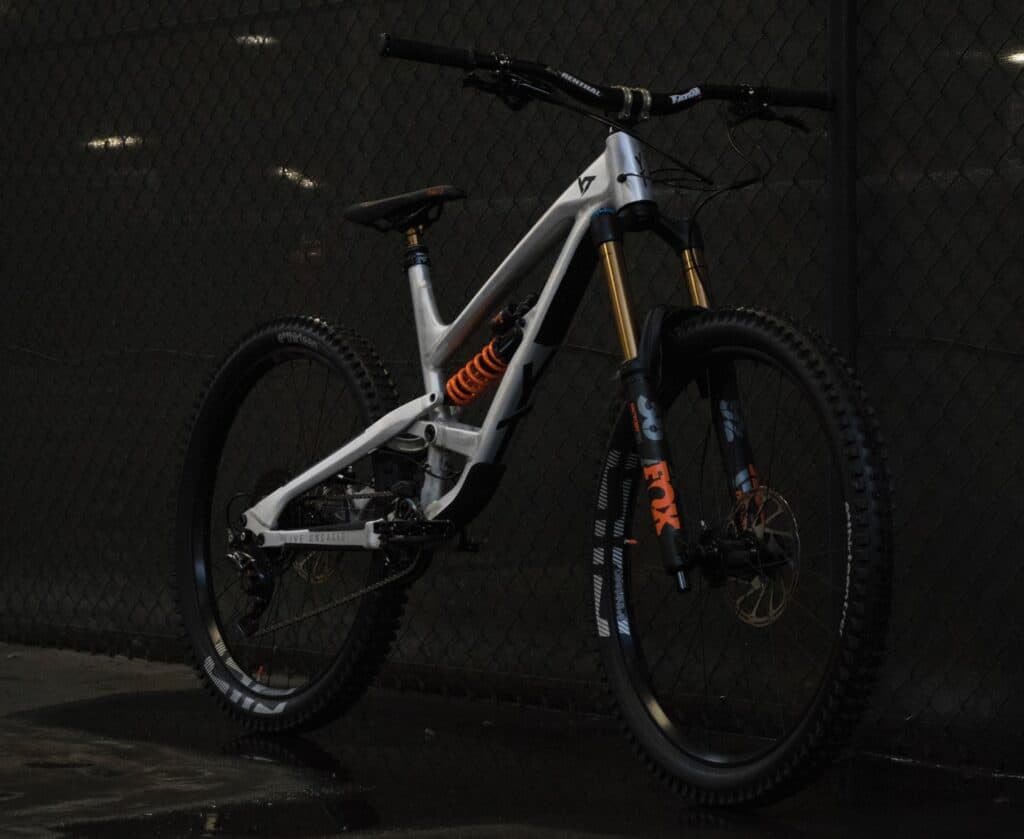
Mountain bikes that have this long, low, slack design are often called “progressive bikes.” (That’s not to be confused with progressive suspension, which refers to the resistance curve of the shock absorber during compression. It’s not related.)
What’s the point of progressive geometry? It greatly improves stability at high speeds, especially in corners and on jumps/drops. The lower center of gravity is probably the biggest factor. The long, low front end can also help you feel more in-control over high-speed impacts.
Are the drawbacks to progressive MTB geometry? The long, low design can be challenging on very tight, twisty trails with lots of rocks and roots. The length is harder to manipulate (although short chainstays mitigate this), and the low bottom bracket will hit more obstacles.
